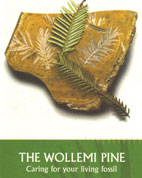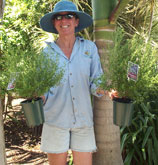
December 2005
The Daley News
"Merry Christmas & Best wishes from Daleys"

We are fast approaching the end of another year - one which has seen many exciting developments here at Daleys. As you all know we are celebrating our 25th anniversary. I would like to take this opportunity on behalf of all the staff to congratulate our wonderful bosses on their successful and progressive venture. I would also like to thank all those of you who responded to our anniversary newsletter. We were overwhelmed with messages of good will. It's still not too late to receive our special FREE $15 anniversary voucher, just go to our November newsletter to receive it.
Another exciting development has been the overhaul of our web site by Correy. This is offering us and our customers some wonderful opportunities to exchange and share knowledge. We now have a space on each of our fruit pages for you to add your tips and experiences on growing fruit trees. I hope that you are all finding our new site user- friendly and simple to use, so please drop us a line if you've got any feedback on the site.
Adding your Tips & Comments
Here at Daleys Nursery we learn a lot about fruit trees from our customers. We invite you to leave your tips and comments on how you grow any of the fruit trees on our  website. These tips will be available for everyone to see and learn from.
website. These tips will be available for everyone to see and learn from.
All you have to do is to find the plant you would like to comment on, and leave your special tips at the bottom of that plant's description. Start by visiting our fruit index or visiting our fruit tree or rainforest sections. We look forward to learning from each other.
Example Tips
- Best time to prune and how?
- When is the fruit ready for picking
- How you keep the bugs away.
- Success with fruiting in marginal climates
What's Fruiting in the Orchard
 The beginning of summer is a delicious time in the orchard. We are enjoying the last of the plums and relishing the grumichamas. For anyone who has not yet tried one of these, they are the next best thing to a cherry and a must for those who live in the sub- tropics. Not only are they scrumptious but they grow on a very attractive glossy green tree and are a favourite amongst the staff here. In addition, the tropical apples are just starting and will keep us fed through to Christmas.
The beginning of summer is a delicious time in the orchard. We are enjoying the last of the plums and relishing the grumichamas. For anyone who has not yet tried one of these, they are the next best thing to a cherry and a must for those who live in the sub- tropics. Not only are they scrumptious but they grow on a very attractive glossy green tree and are a favourite amongst the staff here. In addition, the tropical apples are just starting and will keep us fed through to Christmas.
Speaking of which, from all of us here at Daleys, Merry Christmas and a very happy and fruitful new year!
Fruit Tee of the Month
QUINCE –Cydonia oblonga
 People for millenniums have grown and loved the quince. Originating from Turkey and Iran, they have been cultivated for over 4000 years and have an extremely interesting history. The quince is featured in Roman and Greek history and mythology where it is a symbol of health, happiness, love, fertility and marriage. The quince was dedicated to Venus and Aphrodite and is rumored to be the biblical, 'Forbidden Fruit'.
People for millenniums have grown and loved the quince. Originating from Turkey and Iran, they have been cultivated for over 4000 years and have an extremely interesting history. The quince is featured in Roman and Greek history and mythology where it is a symbol of health, happiness, love, fertility and marriage. The quince was dedicated to Venus and Aphrodite and is rumored to be the biblical, 'Forbidden Fruit'.
 The quince tree is a beautiful, long-lived, often gnarly, twisted and relatively small tree, which grows to about 4 meters. It has a very broad climatic range, growing in both the sub-tropics and temperate Australia. It can withstand temperatures down to -15 degress celsius, and is not affected by late spring frosts that are damaging in cooler mountain regions in Australia. Trees are trained into an open vase shape which allows light to penetrate the tree and for the fruit to ripen evenly. The quince tree is exceptionally hardy and will tolerate extended periods of dry ,however, the production of fruit will suffer under these conditions. In dry arid climates, it is necessary to irrigate the trees during fruit production. It grows well in wet soils but it will prefer well-drained fertile soils.
The quince tree is a beautiful, long-lived, often gnarly, twisted and relatively small tree, which grows to about 4 meters. It has a very broad climatic range, growing in both the sub-tropics and temperate Australia. It can withstand temperatures down to -15 degress celsius, and is not affected by late spring frosts that are damaging in cooler mountain regions in Australia. Trees are trained into an open vase shape which allows light to penetrate the tree and for the fruit to ripen evenly. The quince tree is exceptionally hardy and will tolerate extended periods of dry ,however, the production of fruit will suffer under these conditions. In dry arid climates, it is necessary to irrigate the trees during fruit production. It grows well in wet soils but it will prefer well-drained fertile soils.
 The large pear shaped fruits ripen to yellow from March to May. They are heavy, hard and fragrant when ripe. Care needs to be taken when picking the fruits as they do bruise easily. Quinces are famous for being used to make superb jams and jellies in the kitchen. The fruit has a very high pectin content that makes it ideal for preserves. Marmalade was first made from quinces and the word marmalade originates from the Portuguese word for quince, marmello. In their raw state, the fruits are hard and many varieties are unpalatable, cooking not only brings out the deep flavours in the quince but it also changes the flesh colour from an off whitish colour into an attractive deep pink. The slower and longer the fruit is cooked, the deeper the colour. Quinces are delicious when they are freshly stewed and they have a tart, sweet flavour that can be used to compliment both sweet and savory dishes. Likewise, they are mouth watering when marinated with a little vanilla and sweet liquor. All in all, a very versatile fruit.
The large pear shaped fruits ripen to yellow from March to May. They are heavy, hard and fragrant when ripe. Care needs to be taken when picking the fruits as they do bruise easily. Quinces are famous for being used to make superb jams and jellies in the kitchen. The fruit has a very high pectin content that makes it ideal for preserves. Marmalade was first made from quinces and the word marmalade originates from the Portuguese word for quince, marmello. In their raw state, the fruits are hard and many varieties are unpalatable, cooking not only brings out the deep flavours in the quince but it also changes the flesh colour from an off whitish colour into an attractive deep pink. The slower and longer the fruit is cooked, the deeper the colour. Quinces are delicious when they are freshly stewed and they have a tart, sweet flavour that can be used to compliment both sweet and savory dishes. Likewise, they are mouth watering when marinated with a little vanilla and sweet liquor. All in all, a very versatile fruit.
Wollemi Pine - coming soon
 It is with much anticipation that we await the release of the first Wollemi Pines. April 2006 will see them available Australia wide. We at Daleys are going to be stocking two sizes of this very special pine and we will be selling them at the recommended retail price.
It is with much anticipation that we await the release of the first Wollemi Pines. April 2006 will see them available Australia wide. We at Daleys are going to be stocking two sizes of this very special pine and we will be selling them at the recommended retail price.
150mm pots – approx 40cm tall - $55
200mm pots – approx 60cm tall - $95
We will have a display plant at the nursery from December on for all those who are curious to see and touch this ancient wonder.
 We are now taking orders in advance for all those who wish to be amongst the first to receive their trees. If you would like to pay now you will receive a certificate and a
We are now taking orders in advance for all those who wish to be amongst the first to receive their trees. If you would like to pay now you will receive a certificate and a  Wollemi Pine care booklet to be provided in lieu of the Wollomi being available in April 2006. On the release in April of the first trees you will be notified that your plant is available at Daleys and we can arrange collection at this time. Photos by Jaime Plaza
Wollemi Pine care booklet to be provided in lieu of the Wollomi being available in April 2006. On the release in April of the first trees you will be notified that your plant is available at Daleys and we can arrange collection at this time. Photos by Jaime Plaza
To place you order please phone Kath 0266321441, or contact me
Thank you kindly for you interest. Please contact me if you have any questions.
Bushfood of the Month
Cut Leaf Mint Bush – Prostanthera incisa
There are many different types of cut leaf mint bush. Prostanthera incisa is one of the hardier varieties. It is a fast growing herbaceous shrub to about 1.5m. It grows best in dappled shade in a spot with well-drained but moist soil. It will however grow in less  than perfect conditions; it has been grown as far south as Canberra where it can handle the frost as well as a light dusting of snow. During spring, masses of purple flowers cover the bush almost to the point of completely covering the foliage.
than perfect conditions; it has been grown as far south as Canberra where it can handle the frost as well as a light dusting of snow. During spring, masses of purple flowers cover the bush almost to the point of completely covering the foliage.
The leaves are highly aromatic and they are not very minty but they have an interesting peppery aroma with overtones of woody eucalyptus. They are perfect to plant as a low hedge or border plant where the heady aromas of the Australian bush are released when brushed past. In the kitchen, a small amount of cut leaf mint goes a long way. It does loose its flavour when baked, but is well suited to infusions and can be used in both sweet and savory dishes. It goes well with lamb as an alternative to using mint, and is delicious when used in dressings and marinades. It makes a refreshing tea when infused in boiling water for 3 to 5 minutes. Dried leaves can be used in place of mixed herbs.
Prune back after flowering to maintain a compact bushy habit. Cut leaf mint bush is a fantastic little native for both a habitat garden and a bush food garden. It attracts insects and insect eating birds. It also makes an attractive container plant as long as it is not allowed to dry out.





